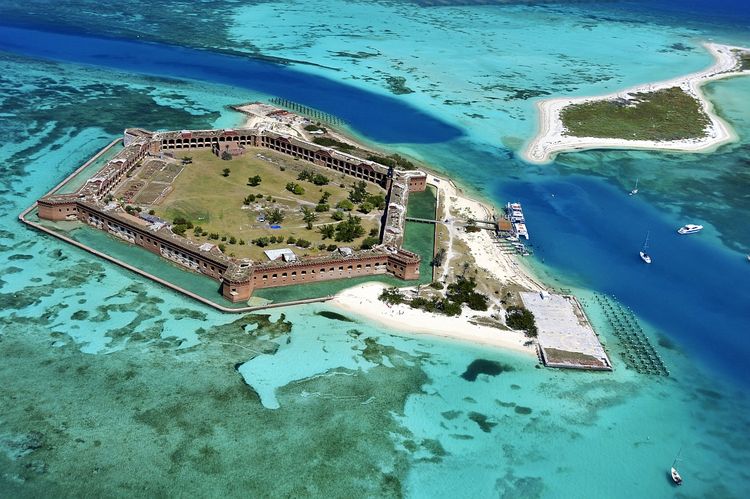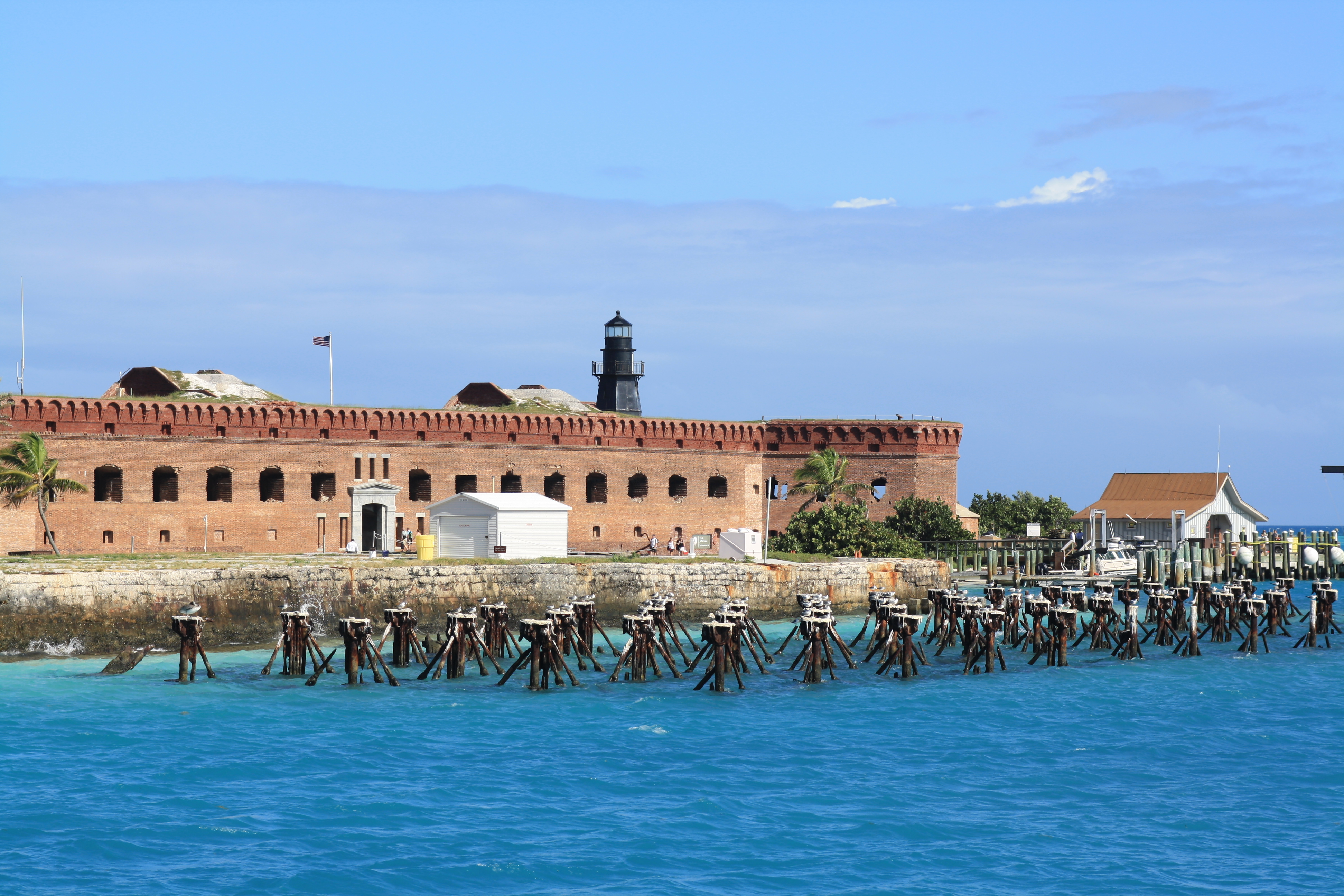National parks maintain their attraction despite the fluctuating nature of tourism patterns. However, there exists a national park that is predominantly submerged, covering 99 percent of its area. It is situated approximately 70 miles away from any urban settlement and can only be reached by means of a seaplane or boat. This national park exhibits a superior level of quality and distinction.

Dry Tortugas National Park is among the three officially declared national parks in the state of Florida, and it holds the distinction of being one of the most geographically isolated areas within the whole United States National Park System. The park is renowned for its remarkably azure waters, intriguing two-century history, pristine ecosystem, and remote tropical setting.
:max_bytes(150000):strip_icc():format(webp)/TAL-header-aerial-dry-tortugas-national-park-fort-jefferson-DRYTORTUGASNP0223-bedb44e2b3a04b7f9f6118eca2c5918d.jpg)
This national park is distinct from others, as confirmed by many who have experienced it firsthand. Do you desire to be included in their ranks? Continue reading to get knowledge on the means of reaching the destination, essential pre-trip information, activities to engage in while on the island, and the optimal period for visiting.I am currently in the process of organizing a visit to Dry Tortugas National Park.
Dry Tortugas National Park is composed of a group of seven little islands, with the majority of the park’s 100-square-mile expanse consisting of water. This water is characterized by its captivatingly azure hue and remarkable clarity, evoking a sense of tropical splendor that surpasses even the most extravagant of imaginings. The Dry Tortugas is an ideal destination for engaging in both swimming and sightseeing, which are considered to be the primary attractions of this location.
:max_bytes(150000):strip_icc():format(webp)/TAL-planning-trip-dry-tortugas-national-park-fort-jefferson-DRYTORTUGASNP0223-c6fe2ccb7c5b41faa91edf588ff5ee09.jpg)
The aesthetic appeal of Dry Tortugas National Park extends beyond its visually captivating waters, encompassing a diverse array of distinctive natural elements such as coral reefs, sandy shoals, abundant marine life, and a plethora of avian species.
Indeed, these natural marvels serve as the primary impetus for the establishment of the park. The National Park Service states that it serves as a valuable source of inspiration and a highly esteemed asset for scientists engaged in study. It is regarded as an optimal outdoor laboratory for the purpose of examining the mechanisms and rationales behind the temporal alterations in natural systems, as well as determining the extent of change that may be considered customary.
:max_bytes(150000):strip_icc():format(webp)/TAL-get-there-seaplane-dry-tortugas-national-park-DRYTORTUGASNP0223-7717097b72574d6ebbd5f2ba8d9f512d.jpg)
The Dry Tortugas Research Natural Area, which was formed in 2007, enhances the value of the resource due to its comprehensive coverage and its purpose of safeguarding the marine environment within the park. According to the National Park Service (NPS), this 46-square-mile protected preserve serves as a refuge for species that have been impacted by fishing activities and the degradation of their natural habitats within the Gulf of Mexico region.
Non-scientific individuals also derive advantages from this significant research endeavor through engaging in recreational activities like boating, diving, and snorkeling in exceptionally unspoiled aquatic environments.
:max_bytes(150000):strip_icc():format(webp)/TAL-kayak-beach-garden-key-dry-tortugas-national-park-DRYTORTUGASNP0223-e51a1292a9d747ce93499f17785dbcf7.jpg)
One of the primary points of interest in this area is the renowned Fort Jefferson, situated on Garden Key, a 14-acre landmass that ranks as the second-largest island within the Dry Tortugas archipelago.
Fort Jefferson, which was first built as a substantial masonry fort in the 19th century, has seen various transformations over its existence. The location in question has functioned as a strategic coaling station for warships, providing a vital refueling point. Additionally, it has acted as a secure haven for ships engaged in patrolling activities throughout the Gulf of Mexico and the Straits of Florida, offering opportunities for resupply and necessary repairs. Furthermore, during the Civil War, it was utilized as a detention facility for Union deserters. However, it is worth noting that Fort Jefferson remained unscathed by any attacks, thereby carrying out its intended purpose as a formidable deterrent to hostile military troops.

Presently, the aforementioned structure stands as a meticulously conserved artifact, adorned with ornamental brickwork and boasting an impressive assemblage of 2,000 arches. Within its confines, visitors have the opportunity to delve into a somewhat obscure facet of American history, one that intertwines global commerce lines, the realities of wartime existence, and the multitude of shipwrecks that occurred in its vicinity. Key Considerations Prior to Visiting Dry Tortugas National Park
Dry Tortugas National Park is a prime example of how challenging expeditions often provide significant benefits. The location of this destination is quite distant from many amenities and attractions. Although its isolation contributes to its allure, visiting this place necessitates more advanced planning compared to a spontaneous visit to a typical national park.

The park lacks vehicular accessibility and does not provide amenities such as fuel, water, charcoal, or food. Therefore, it is imperative to come adequately equipped for the entirety of your visit. The popularity of day trips as a means to explore the Dry Tortugas can be attributed to several factors.

Furthermore, it should be noted that the park lacks any provisions and amenities. The sole restroom facilities may solely be accessed on the Yankee Freedom ferry, which is exclusively accessible during its docking hours. Composting toilets are provided for overnight campers during the designated hours of 3 p.m. to 10:30 a.m. on a daily basis.
Dry Tortugas National Park does not provide cellular coverage, internet access, or Wi-Fi services. In the contemporary era characterized by extensive interconnectivity, the aforementioned attribute constitutes a distinctive feature of the park. However, it is imperative for individuals to adequately equip themselves for an immersive experience devoid of modern technological amenities.
:max_bytes(150000):strip_icc()/TAL-snorkling-dry-tortugas-national-park-DRYTORTUGASNP0223-92df1f34aecc4b25a937e3063fc54bc2.jpg)
Moreover, due to the limited ingress and egress points of the park, visiting entails a full-day dedication. Consequently, one cannot just alter their decision and return home if they are not inclined to continue.
If the prospect of being marooned on a remote tropical island for a day, with restricted availability of sustenance, water, restroom facilities, and other contemporary amenities, fails to elicit your interest, it may be advisable for you to abstain from participating in this endeavor. However, if one is inclined towards embarking on such expedition, they are in for a delightful experience.